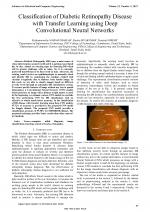| 3/2021 - 6 |
Classification of Diabetic Retinopathy disease with Transfer Learning using Deep Convolutional Neural NetworksSOMASUNDARAM, K. |
| Extra paper information in |
| Click to see author's profile in |
| Download PDF |
Author keywords
computer aided diagnosis, image classification, learning, neural networks, retinopathy
References keywords
image(12), learning(8), diabetic(8), classification(8), retinopathy(7), deep(7), recognition(6), neural(6), convolutional(5), retinal(4)
Blue keywords are present in both the references section and the paper title.
About this article
Date of Publication: 2021-08-31
Volume 21, Issue 3, Year 2021, On page(s): 49 - 56
ISSN: 1582-7445, e-ISSN: 1844-7600
Digital Object Identifier: 10.4316/AECE.2021.03006
Web of Science Accession Number: 000691632000006
SCOPUS ID: 85114777184
Abstract
Diabetic Retinopathy (DR) stays a main source of vision deterioration around world and it is getting exacerbated day by day. Almost no warning signs for detecting DR which will be greater challenge with us today. So, it is extremely preferred that DR has to be discovered on time. Adversely, the existing result involves an ophthalmologist to manually check and identify DR by positioning the exudates related with vascular irregularity due to diabetes from fundus image. In this work, we are able to classify images based on different severity levels through an automatic DR classification system. To extract specific features of image without any loss in spatial information, a Convolutional Neural Network (CNN) models which possesses an image with a distinct weight matrix is used. In the beginning, we estimate various CNN models to conclude the best performing CNN for DR classification with an objective to obtain much better accuracy. In the classification of DR disease with transfer learning using deep CNN models, 97.72% of accuracy is provided by the proposed CNN model for Kaggle dataset. The proposed CNN model provides a classification accuracy of 97.58% for MESSIDOR dataset. The proposed technique provides better results than other state-of-art methods. |
| References | | | Cited By |
Web of Science® Times Cited: 2 [View]
View record in Web of Science® [View]
View Related Records® [View]
Updated 2 weeks, 6 days ago
SCOPUS® Times Cited: 2
View record in SCOPUS® [Free preview]
View citations in SCOPUS® [Free preview]
[1] A Systematic Review of Transfer Learning-Based Approaches for Diabetic Retinopathy Detection, OLTU, Burcu, KARACA, Büşra Kübra, ERDEM, Hamit, ÖZGÜR, Atilla, Gazi University Journal of Science, ISSN 2147-1762, Issue 3, Volume 36, 2023.
Digital Object Identifier: 10.35378/gujs.1081546 [CrossRef]
[2] A multiclass deep learning framework for retinal disease detection using VGG16-HCCNN, Latha, G, Priya, P Aruna, Physica Scripta, ISSN 0031-8949, Issue 5, Volume 100, 2025.
Digital Object Identifier: 10.1088/1402-4896/adc51e [CrossRef]
Disclaimer: All information displayed above was retrieved by using remote connections to respective databases. For the best user experience, we update all data by using background processes, and use caches in order to reduce the load on the servers we retrieve the information from. As we have no control on the availability of the database servers and sometimes the Internet connectivity may be affected, we do not guarantee the information is correct or complete. For the most accurate data, please always consult the database sites directly. Some external links require authentication or an institutional subscription.
Web of Science® is a registered trademark of Clarivate Analytics, Scopus® is a registered trademark of Elsevier B.V., other product names, company names, brand names, trademarks and logos are the property of their respective owners.
Faculty of Electrical Engineering and Computer Science
Stefan cel Mare University of Suceava, Romania
All rights reserved: Advances in Electrical and Computer Engineering is a registered trademark of the Stefan cel Mare University of Suceava. No part of this publication may be reproduced, stored in a retrieval system, photocopied, recorded or archived, without the written permission from the Editor. When authors submit their papers for publication, they agree that the copyright for their article be transferred to the Faculty of Electrical Engineering and Computer Science, Stefan cel Mare University of Suceava, Romania, if and only if the articles are accepted for publication. The copyright covers the exclusive rights to reproduce and distribute the article, including reprints and translations.
Permission for other use: The copyright owner's consent does not extend to copying for general distribution, for promotion, for creating new works, or for resale. Specific written permission must be obtained from the Editor for such copying. Direct linking to files hosted on this website is strictly prohibited.
Disclaimer: Whilst every effort is made by the publishers and editorial board to see that no inaccurate or misleading data, opinions or statements appear in this journal, they wish to make it clear that all information and opinions formulated in the articles, as well as linguistic accuracy, are the sole responsibility of the author.



